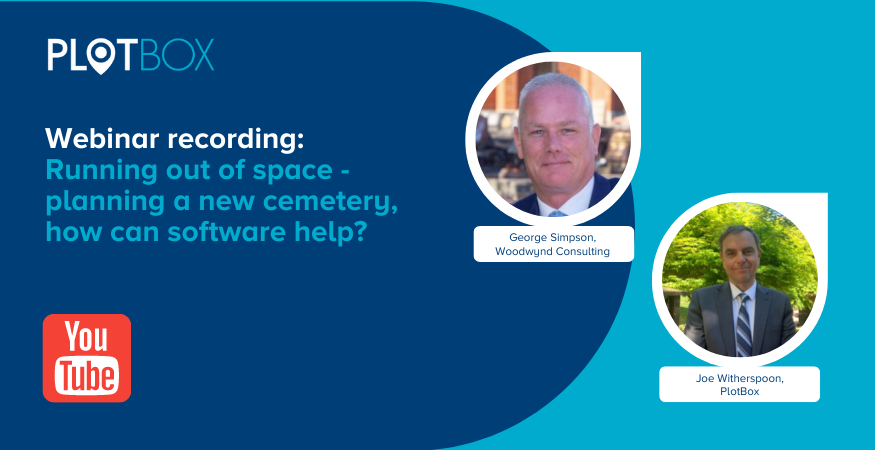During a recent webinar, we spoke with George Simpson of Woodwynd Consulting, a Funeral industry professional with over 30 years experience working within the Funeral sector in Australia and internationally.
Throughout the course of our discussion, we defined some of the most prevalent challenges faced by Australian cemetery operators - primarily that of space - and how integrated cemetery software and mapping can help them to overcome them. Here are a few of the key learnings:
Space and the current state of play
As addressed in the NSW Government’s 11th Hour report into the NSW Cemeteries Act 2013, cemetery operators are running out of space. The issue of space, not just in New South Wales, but right across Australia, has been well documented over the last twenty years, reflecting the challenges faced by cemeteries on a monthly, weekly and even daily basis.
As such, cemetery operators are looking for ways to stretch the lifespan of their cemeteries for generations to come; but with greenfield sites in short supply, it can be difficult for operators to find innovative ways to use the space that they have.
The risk of paper records
Many Australian cemetery operators still use old, ‘mountainous’ volumes of paper records - some even dating back 150 to 200 years. Not only are they highly inefficient, and labour intensive, but as they’re not always accurate, they can pose a huge risk. And while some operators have moved to using spreadsheets for example, with each transfer of information, there is the very real risk of diluting the clarity of the information.
In terms of a real-world example - as we know, providing regulators with accurate information is very important - and something that a cemetery management software solution can allow you to do in a fraction of the time and with much greater efficiency.
Loss of institutional knowledge
Quite often, cemetery operators rely on ‘institutional knowledge’ - the knowledge carried ‘in the head’ of long-serving members of staff - often not written down, stored or accessible by anyone else. What happens to that wealth of knowledge when that person moves on or retires? What risk does staff attrition pose in terms of continuity of information and knowledge? What systems or processes are in place to avoid that loss?
Maximising available space
Another challenge for operators is having a clear understanding of their current inventory in order to make the most of the space available to them. It’s important to know exactly what inventory you possess at any one time - reducing the risk of building more inventory into the project than you actually have.
Demolishing an old building? Using an old roadway or pathway? Integrated cemetery software will provide the visibility you need to do this accurately, make processes more efficient, and ensure that you have the right people in the right place.
Accurate forecasting and pre-planning
Key to making informed business decisions about the future is the ability to accurately forecast the rate at which you are running out of space. That can be a challenge when information is not easily accessible, either in written records or disjointed systems. Consider then, the benefits of a system that allows for live inventory updates - letting you pull reports that show run rates and clear sales comparisons. Having that information easily to hand, rather than trawling through books and ledgers - in some cases trying to remember what happened in the past - can be taxing, both for individuals and for the organisation.
Double-sold plots
Another benefit of having cemetery software that provides live updates is in avoiding the risks associated with double-selling plots. There are many examples of counselors selling the same plot on the same day, and due to the limitations of processes in place, the duplication may not be picked up for several weeks, if at all. This of course poses a very real risk to the operator, and importantly - potential distress for families. A software system with linked plot data that updates in real time can help to avoid this happening.
Building out inventory and stock management
Another benefit of a cemetery management system such as PlotBox is that it enables cemetery managers to clearly visualise and plan out sales of their inventory. For example, should they wish to block off or put a hold on certain spaces to help control and predict the flow of sales, they can do that quite easily. In fact, it provides everything cemeteries need to manage their sales processes more efficiently, providing absolute transparency for the team at all stages.
It also helps to provide a better experience for the customer - high resolution maps, linked to plot data allows them to see clearly exactly what they are buying and where, building trust and engagement. This is especially important where due to size or location it may be difficult to visit the actual grave site.
Changing customer expectations and the future of cemetery operations
The customer experience is increasingly becoming a digital one, and as younger generations come through - and even move into the deathcare sector - expectations in terms of how we interact with technology are changing and evolving. The ability, for example, for families to be able to visualise their loved one’s grave and have directions straight from a website or tablet - such as PlotBox’s ‘walk-to-grave function - will become not just a nice to have but it will be expected and have huge benefits for the customer.
Similarly, providing stakeholders or deathcare partners with 24/7 online access to cemetery booking diaries to provisionally book slots out of hours - such as the PlotBox Funeral Director portal, will help to meet these changing expectations, while providing huge benefits for the cemetery, their partners and ultimately the family.
A ‘single source of truth’
Communication is the lifeblood of any cemetery organisation. Communication between systems, teams, individuals and with families. The ‘single source of truth’ that a cemetery software management system such as PlotBox affords, removes silos of information, and provides the same, clear and accurate and easily accessible data to all members of the cemetery team. In this way, it helps operators to not only increase efficiencies, but decrease risk, maximise their inventory, empower their sales teams, meet changing customer expectations, and importantly - plan and take the action they need to secure their future.
To learn more, view the webinar in full at the link below:

